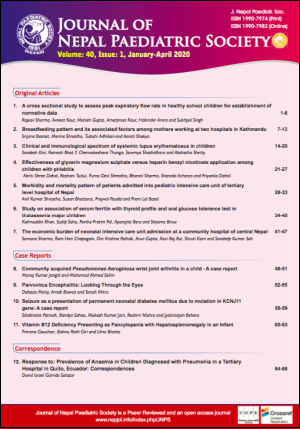Study on Association of Serum Ferritin With Thyroid Profile And Oral Glucose Tolerance Test in Thalassemia Major Children
DOI:
https://doi.org/10.3126/jnps.v40i1.28472Keywords:
endocrinopathies, serum ferritin, Thalassemia majorAbstract
Introduction: The free iron and haemosiderosis-induced damage of the endocrine glands cause endocrinopathies such as abnormal glucose tolerance and hypothyroidism in transfusion - dependent beta-thalassemia major patients. Our objective was to study the association of serum ferritin level with thyroid dysfunctions; abnormal blood glucose tolerance and to see if they appear in the earlier period of life.
Methods: This cross-sectional study was done among thalassemia major children of two to 12 years in a tertiary care hospital, Kolkata, India. A pre-designed proforma was filled. Serum ferritin, fT4, TSH level, and oral glucose tolerance test (OGTT) were measured at presentation and noted in proforma.
Results: A total of 80 thalassemic children were studied. Fiftieth percentile cut off value (1414 ng/ml) of serum ferritin was found to be significant with associated variables like normal fT4, TSH, and OGTT. Out of all study subjects, 39 (51.3%) of normal fT4, 39 (54.9%) of normal TSH and 39 (52.0%) of normal OGTT had ferritin < 50th percentile (P < 0.05). Nine (11.3%) children had abnormal thyroid profiles and five (6.3%) children had abnormal OGTT having ferritin > 2000 ng/ml. At a cut off value of ferritin level > 1414 ng/ml, fT4, TSH and OGTT showed significant abnormality (p < 0.05 with df 1).
Conclusions: Ferritin is a good indirect marker to assess the risk of endocrine abnormality in thalassemic children. Frequent monitoring should be done once ferritin level crosses 1000 ng/ml. This will help in early detection and timely management of thalassemia related endocrinopathies.
Downloads
Downloads
Published
How to Cite
Issue
Section
License
Authors who publish with this journal agree to the following terms:
Authors retain copyright and grant the journal right of first publication with the work simultaneously licensed under a Creative Commons Attribution License that allows others to share the work with an acknowledgement of the work's authorship and initial publication in this journal.
Authors are able to enter into separate, additional contractual arrangements for the non-exclusive distribution of the journal's published version of the work (e.g., post it to an institutional repository or publish it in a book), with an acknowledgement of its initial publication in this journal.
Authors are permitted and encouraged to post their work online (e.g., in institutional repositories or on their website) prior to and during the submission process, as it can lead to productive exchanges, as well as earlier and greater citation of published work (See The Effect of Open Access).



